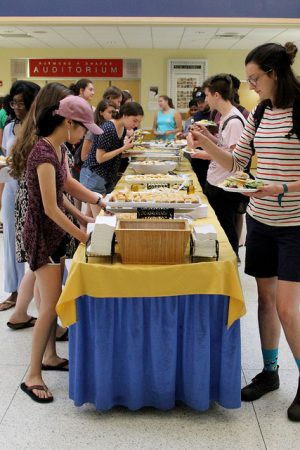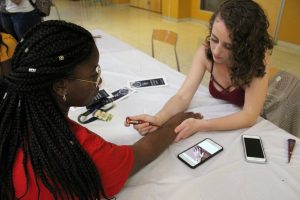ICA brings traditional celebration to Allegheny
Festival showcases tradition, Middle Eastern food, cultural activities
Allegheny College’s Islamic Cultural Association held a celebration of the festival Eid al-Adha in the lobby of the George M. Henderson Campus Center on Sunday, Sept. 17.
Muhammad Jallow, ’21, attended the event. He explained the background behind the Eid al-Adha ceremony.
“Translated, the day means the Day of Sacrifice, so it was the day God commanded [the prophet Ibrahim] to slaughter his son, but instead, he replaced it with a sheep, so that’s what the celebration is about,” Jallow said.
Translated, the day means the Day of Sacrifice, so it was the day God commanded [the prophet Ibrahim] to slaughter his son, but instead, he replaced it with a sheep, so that’s what the celebration is about.
— Muhammad Jallow, Class of 2021
During the celebration, members of the student body stopped by the festival and sampled Middle Eastern food. The club also provided a canvas backdrop, in front of which people took pictures. Music played on loudspeakers in the background.
“If you look around, the decorations, we try to bring a setting like a house setting, a home setting,” ICA Co-President Tolossa Hassan, ’18, said.
Hassan explained that Eid al-Adha was the second of two festivals. While it technically occurred on Sept. 1, the club decided to hold a later public celebration due to scheduling issues.
“The first one is right after Ramadan, which this year was in the summer, and then a month later we have another Eid, which is the Eid of Sacrifice,” Hassan said. “We’re celebrating it a little bit later because that’s what everyone’s schedule is, but it was on the first.”
Hassan said that as well as celebrating an Islamic holiday, ICA’s Eid al-Adha festival incorporated a station where people could receive henna designs. While the tattoos are worn during Eid al-Adha, they have become a stand-alone cultural icon.
“Henna is something that a lot of people put on the day before, the night before, so we try to like, [show] not just Islamic religion, but the culture as well,” Hassan said.
Baneen Al-Akashi, ’19, said that the second Eid comes during the end of the traditional Hajj, or pilgrimage season, in which many Muslims travel to Mecca in Saudi Arabia.
“The second one is when you do Hajj, which is required for all Muslim people to do at least once in their lifetime,” Al-Akashi said.
Al-Akashi said those not on Hajj during Eid al-Adha celebrated with prayer and family.
“Usually people go to the mosque and do prayer there as a group, and then they’ll do a huge celebration at their houses, with their family,” Al-Akashi said.
Valerie Calvo, ’21, said that while she was originally drawn to the ceremony because of the food, she felt the cultural aspects of the celebration were also interesting.
“Oh, it’s really nice,” Calvo said. “You know, they don’t just have food, they have the decorations and people to represent their own culture, it’s really cool.”

Students help themselves to a buffet in celebration of Eid Al-Adha hosted by the Islamic Cultural Association.

Olivia Heeb, ‘19, gives Benedicte Musimisa, ‘21, a henna tattoo at the Islamic Cultural Association’s event to celebrate Eid Al-Adha on Sunday, Sept. 17, 2017.








